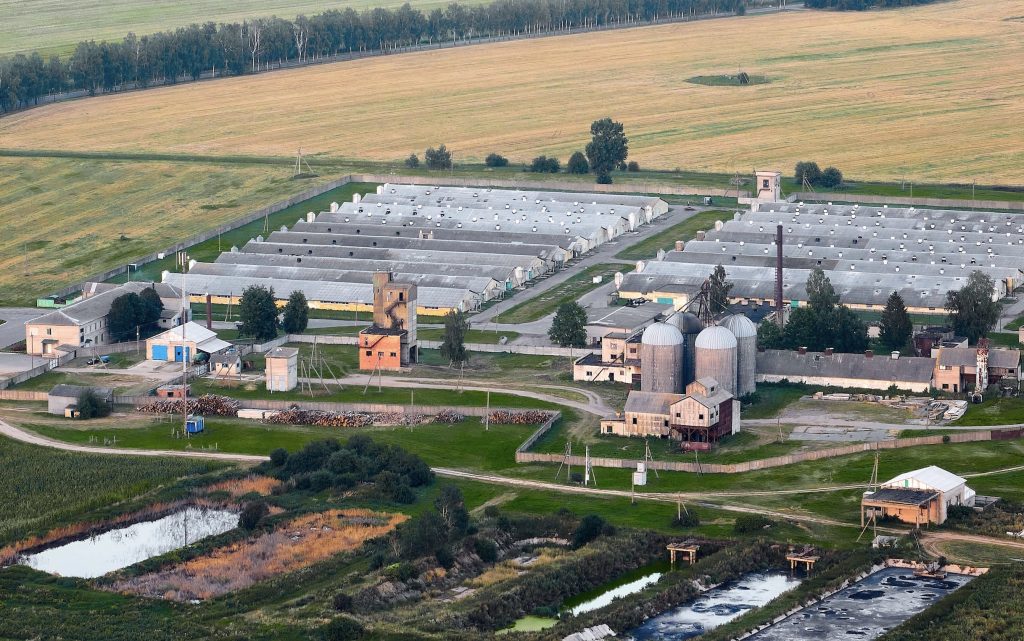Last year, the Inflation Reduction Act (IRA) made headlines for providing billions of dollars to popular conservation programs — but as a recent Congressional letter points out, the U.S. Department of Agriculture (USDA) is instead using much of this taxpayer money to subsidize phony conservation practices by the largest, corporate-controlled industrial operations.
USDA’s Natural Resources Conservation Service (NRCS) recently made new agriculture activities eligible for $2.1 billion in IRA conservation funding to help mitigate extreme weather events. Concerningly, many of the practices deemed eligible for this funding are primarily used by the largest industrial concentrated animal feeding operations (CAFOs), such as the costly processing of liquid waste from noxious manure lagoons.
Here’s the thing: The IRA conservation dollars were meant to support farmers who are typically underserved by current USDA conservation programs. Meanwhile, these corporate-controlled industrial farms are already flush with taxpayer-funded subsidies.
Under NRCS’ plan, small and medium-sized farms that need the support for regenerative practices will continue to be left out, while large operations employing practices that clash with the IRA’s conservation goals are further incentivized with taxpayer dollars.
A Misguided Interpretation of Conservation
At first glance, the projects funded by the IRA through USDA would indeed benefit smaller producers working to steward their land and protect its natural resources, including funding for cover crops, reduced-till and no-till practices, and improved grazing practices.
But this isn’t the case for all of the eligible activities. Projects such as waste storage facilities, roofs and covers for biogas capture facilities, and waste separation facilities don’t support the IRA’s original conservation goals and should not be eligible for this funding. These projects focus on reactive management to clean up the harm incurred by industrial practices, rather than preventing the damage in the first place — hardly an appropriate use of conservation dollars.
This isn’t the first time USDA has made misguided conservation funding decisions. CAFOs were already able to get conservation funding for harmful projects like methane digesters before NRCS expanded its eligible practices — but now there’s even more funding available for them. Industrial carbon sequestration practices like methane digesters are actively harmful: They process methane from CAFOs’ manure pits into “natural” gas, so they are not a renewable energy source. Methane digesters merely encourage the expansion of industrial livestock operations and do not progress IRA’s conservation goals.
Putting Taxpayer Dollars into the Wrong Hands
These industrial practices are also very expensive, and conservation programs like the Environmental Quality Incentives Program (EQIP) are already heavily oversubscribed. Between 2010-2020, the USDA turned away more than two thirds of farmers seeking conservation assistance due to high demand, leaving nearly one million farmers without access to this much-needed support.
Meanwhile, EQIP funds fewer and more expensive projects that disproportionately benefit large-scale industrial agriculture operations. Notably, CAFOs were explicitly excluded from EQIP funding before the 2002 Farm Bill. Since this controversial change, large portions of taxpayer-backed EQIP funds support just a handful of costly band-aid projects that not only fail to address but further incentivize the industrial practices that degrade our natural resources in the first place.
In some states, as much as 37% of EQIP funds are directed toward such projects — like building storage facilities or treatment lagoons to process the large amounts of waste created by CAFOs. This is a highly inefficient use of funding: Projects like waste storage facilities cost about $100,000 per contract, for example. Compare the use of $3 million of Minnesota’s EQIP funding for just 38 CAFO “waste facility covers” with the 850 prescribed grazing projects (rotating the sections of pasture that are actively grazed to allow other sections to rest) that were made possible with just $2 million EQIP dollars in Kansas.
The addition of even more industrial practices that are eligible for conservation funding only exacerbates this already unbalanced funding distribution, which leaves fewer resources available for small and medium-sized family farms employing practices with proven environmental benefits, such as rotational grazing or cover cropping.
USDA Should Reconsider
This misguided decision to expand eligible activities comes on the heels of USDA’s disappointing dispersal of $2.8 billion in funding for “Partnerships for Climate-Smart Commodities,” in which the lion’s share of funding was awarded to the likes of JBS, Tyson, and Coca-Cola. While the second round of this funding did target conservation projects for smaller farms and underserved producers, operations with the least need for the funding have received too many taxpayer dollars from USDA as it is — they don’t need more opportunities to rake in conservation dollars now that more industrialized practices are eligible for funding.
We echo the concerns from the recent Congressional letter to USDA Secretary Tom Vilsack: Authorizing the use of this conservation funding for these industrial practices “will further consolidate the agricultural sector by rewarding the largest firms.” This is not how USDA should be spending IRA’s conservation dollars.
In 2020 alone, EQIP funded more than 10,000 contracts for producers to implement cover cropping in Midwestern states. This is a great start, and offers precisely the kind of hand up to small and mid-scale producers that IRA funding should support.
When distributing IRA conservation funds, Farm Action would like to see USDA more narrowly target projects from family farmers that are directly in line with IRA goals, such as prescribed grazing and cover cropping, which have proven benefits to our natural resources. Farm Action will continue to urge USDA to promote meaningful conservation efforts by supporting the farmers who need it the most.
Written and edited by: Jessica Cusworth, Dee Laninga, Angela Huffman, and Joe Maxwell. Concept developed by: Angela Huffman and Joe Maxwell.



